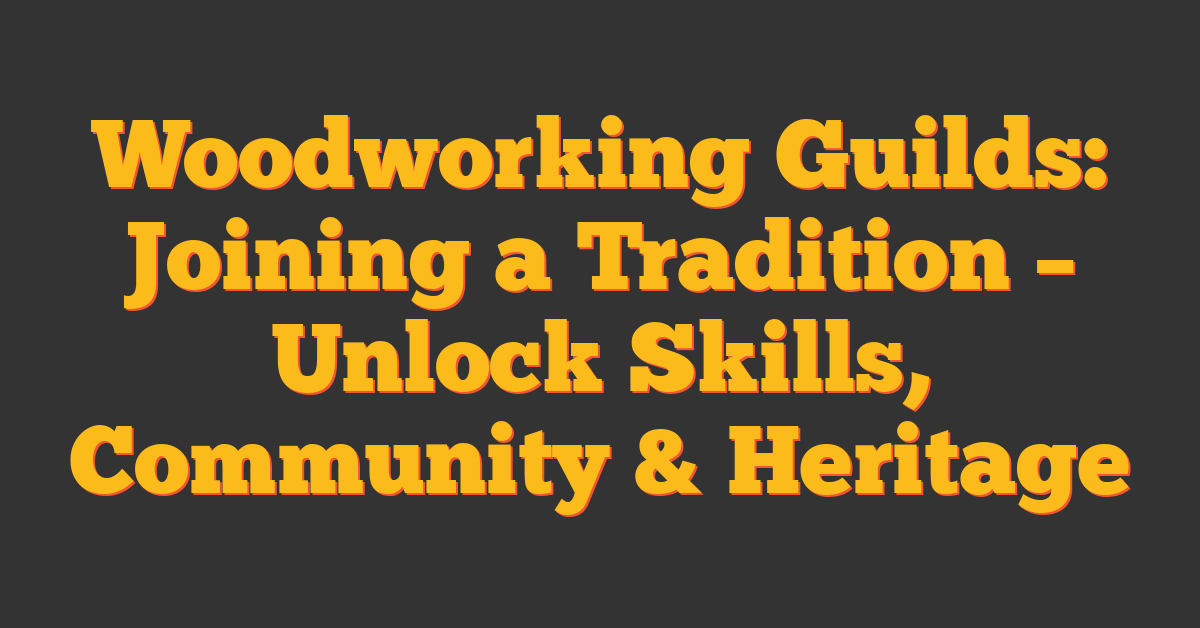If you’re looking to explore the world of woodworking, taking a class can be a great way to get started. Woodworking classes for adults are available in many locations, from community centers to specialized schools. These classes can teach you the fundamentals of woodworking, including basic techniques for cutting, sanding, and finishing wood.

Woodworking classes come in many different forms, from one-day workshops to multi-week courses. Some classes may focus on a specific type of woodworking, such as furniture making or woodturning, while others may cover a range of techniques. When choosing a class, consider your skill level and interests, as well as the time commitment and cost. You may also want to look for classes that provide hands-on experience, as this can be a great way to learn new skills and gain confidence in your abilities.
Whether you’re a beginner or an experienced woodworker, taking a class can be a great way to improve your skills and learn new techniques. By exploring the world of woodworking through classes, you can discover new ways to express your creativity and build beautiful, functional objects out of wood.
Key Takeaways
- Woodworking classes are available for adults in many locations and formats.
- When choosing a class, consider your skill level, interests, time commitment, and cost.
- Taking a woodworking class can help you improve your skills, learn new techniques, and express your creativity.
Exploring Woodworking
https://www.youtube.com/watch?v=Iz24N–APtI&embed=true
Woodworking is a fascinating and rewarding hobby that allows you to create beautiful and functional objects out of wood. Whether you are a beginner or an experienced woodworker, there is always something new to learn and explore in this craft. In this section, we will cover the basics of woodworking, the materials and tools you need, safety considerations, woodworking techniques, design and planning, specialized skills, and projects to start with.
Understanding the Basics
Before you start any woodworking project, it’s important to understand the basics of the craft. This includes the different types of wood, the basic tools and materials you’ll need, and some of the common techniques used in woodworking. You can find a wealth of information on these topics online, including websites like Instructables and Fine Woodworking.
Materials and Tools
To get started with woodworking, you’ll need some basic materials and tools. The materials you’ll need will depend on the project you’re working on, but some common ones include wood, sandpaper, glue, and finishing materials like stain or varnish. As for tools, you’ll need both hand tools and power tools. Some common hand tools include chisels, hand saws, and clamps, while power tools like a bandsaw or router can make your work easier and more efficient.
Safety First
Safety is a top priority in woodworking, and it’s important to take the necessary precautions to protect yourself while you work. This includes wearing appropriate personal protective equipment (PPE), such as safety glasses and hearing protection, and using dust collection systems to prevent respiratory problems. You should also be aware of the potential hazards of your tools and equipment, and take steps to minimize the risk of injury.
Woodworking Techniques
There are many different techniques used in woodworking, from carving and shaping to joinery and veneering. Some common techniques include mortise and tenon joints, router techniques, and decorative inlay. You can learn more about these techniques online or by taking a class at a local woodworking school or community center.
Design and Planning
Before you start any woodworking project, it’s important to have a clear plan in place. This includes designing your project, selecting the right materials, and creating a detailed cutting list. You can use software like SketchUp to create 3D models of your designs and visualize your project before you start cutting.
Specialized Skills
Once you’ve mastered the basics of woodworking, you may want to explore some more specialized skills. This could include furniture design, cabinetry, or even spoon carving. There are many resources available online and in-person to help you develop these skills, including classes and workshops.
Projects to Start With
If you’re new to woodworking, it’s a good idea to start with some simple projects to build your skills and confidence. Some great projects for beginners include cutting boards, nightstands, and utensils. As you become more comfortable with the craft, you can move on to more advanced projects like furniture and cabinetry.
Advanced Projects
For experienced woodworkers, there are many challenging and rewarding projects to explore. This could include intricate marquetry work, complex furniture designs, or even building your own woodworking tools. Whatever your interests and skill level, there is always something new to learn and explore in the world of woodworking.
Types of Woodworking Classes

Woodworking is a great way to express your creativity and learn new skills. Whether you are a beginner or an experienced woodworker, there are many types of woodworking classes available to help you improve your skills and create beautiful projects. In this section, we will explore some of the different types of woodworking classes you can take.
Beginner Woodworking Classes
If you are new to woodworking, beginner woodworking classes are the perfect place to start. These classes are designed to teach you the basics of woodworking, including how to use tools, measure and cut wood, and assemble projects. Many beginner woodworking classes are offered in-person at woodworking stores like Woodcraft or Rockler, and cover topics such as furniture building, jewelry making, and more.
Intermediate and Advanced Classes
If you have some experience with woodworking, intermediate and advanced classes can help you take your skills to the next level. These classes focus on more complex projects and techniques, such as joinery, carving, and finishing. Some popular intermediate and advanced woodworking classes include The Weekend Woodworker, Woodworking Masterclasses, and online courses on Udemy.
Specialty Workshops
Specialty workshops are a great way to learn specific woodworking techniques or create a particular type of project. These workshops are often taught by experts in their field and offer a more focused learning experience. Some popular woodworking workshops include Rockler’s knife making workshop, Taunton Workshops, and Craftsy’s woodworking courses.
Online Learning Opportunities
If you prefer to learn at your own pace or don’t have access to in-person classes, online learning opportunities can be a great option. Many woodworking experts offer online classes and tutorials, covering everything from basic woodworking skills to advanced techniques. Some popular online learning platforms for woodworking include Udemy, Skillshare, and Craftsy.
No matter what type of woodworking class you choose, remember to have fun and be patient with yourself as you learn new skills. With practice and dedication, you can become a skilled woodworker and create beautiful projects that you can be proud of.
Choosing the Right Class
https://www.youtube.com/watch?v=s17chuxvQ9c&embed=true
Woodworking classes can be a great way to learn new skills and techniques, but with so many options available, it can be difficult to know where to start. Here are a few things to consider when choosing the right class for you.
Assessing Skill Level
Before you start looking for classes, it’s important to assess your skill level. If you’re a beginner, you’ll want to look for classes that focus on the basics, such as safety, tool use, and joinery. If you already have some professional skill, you may want to look for intermediate or advanced classes that focus on more complex techniques and projects.
In-Person vs. Online
One of the first decisions you’ll need to make is whether you want to take in-person or online classes. In-person classes offer the benefit of hands-on instruction and the opportunity to work with other students. Many art centers, community colleges, woodworking clubs, and woodworking schools offer in-person workshops and classes. On the other hand, online learning can be more flexible and convenient, allowing you to learn at your own pace and on your own schedule.
Finding Classes Near You
If you decide to take in-person classes, you’ll need to find woodworking classes near you. Some good places to start your search include local art centers, community colleges, woodworking clubs, and home improvement stores like Home Depot. You can also search online for woodworking classes in your area. When choosing a class, be sure to read reviews and ask for recommendations from other woodworkers.
Overall, choosing the right woodworking class comes down to assessing your skill level, deciding whether in-person or online learning is right for you, and finding classes near you that fit your needs and schedule.
Getting the Most Out of Classes

Whether you are a beginner or an experienced woodworker, taking classes is an excellent way to improve your skills, learn new techniques, and connect with like-minded individuals. Here are some tips on how to get the most out of your woodworking classes:
Hands-On Experience
One of the most significant benefits of taking woodworking classes is the hands-on experience you gain. Take advantage of this opportunity by actively participating in class projects and asking questions. Don’t be afraid to make mistakes; they are a natural part of the learning process. Take notes, practice what you learn, and apply the techniques you learn in class to your own projects.
Networking and Community
Woodworking classes provide an excellent opportunity to network and connect with other woodworkers. Joining a woodworking club or becoming a member of the Woodworkers Guild of America can help you build relationships with other woodworkers and gain access to valuable resources. Take advantage of the opportunity to connect with others in the woodworking community and learn from their experiences.
Continued Learning
Woodworking is a lifelong learning process, and taking classes is an excellent way to continue your education. Whether you are looking to expand your skills or learn new techniques, there are many options available for continued learning. Consider taking online courses, attending in-person workshops, or enrolling in continuing education classes at a community college or high school.
In conclusion, taking woodworking classes can be a valuable investment in your skills and provide you with a sense of community. By actively participating in class projects, networking with other woodworkers, and continuing your education, you can get the most out of your woodworking classes and improve your skills as a woodworker.
Beyond the Classroom
https://www.youtube.com/watch?v=sHG6PZ1lvto&embed=true
Congratulations, you’ve completed your woodworking class! You’ve learned the basics and honed your skills, but what’s next? Here are a few ideas to keep you motivated and help you take your woodworking hobby to the next level.
Starting Your Own Projects
Now that you’ve learned the basics of woodworking, why not start your own project? You can create anything from a simple cutting board to a complex piece of furniture. The possibilities are endless! To get started, you’ll need to choose a project and gather the necessary materials and tools. Don’t forget to take measurements and plan out your project before you start cutting. This will help you avoid mistakes and ensure that your project turns out the way you want it to.
Turning Woodworking into a Business
If you’re passionate about woodworking and have a talent for it, why not turn it into a business? You can sell your creations online or at local craft fairs. To get started, you’ll need to create a portfolio of your work and set up a website or social media page to showcase your creations. You’ll also need to set prices for your work and decide how you’ll handle shipping and handling.
Advanced Techniques and Mastery
If you’re serious about woodworking and want to take your skills to the next level, consider taking advanced woodworking classes or attending woodworking masterclasses. These classes are designed for experienced woodworkers who want to learn new techniques and improve their skills. You’ll learn advanced techniques such as joinery, carving, and turning, and you’ll have the opportunity to work with professional woodworkers who can help you master your craft.
In conclusion, woodworking is a rewarding hobby that can be taken to the next level. Whether you want to start your own projects, turn woodworking into a business, or master advanced techniques, there are plenty of opportunities to grow and improve your skills. So go ahead and take the next step in your woodworking journey!
Supplies and Resources
https://www.youtube.com/watch?v=yVm1XKB-tiY&embed=true
Woodworking can be an expensive hobby, but with the right supplies and resources, it doesn’t have to break the bank. Here are some options for finding affordable and high-quality supplies, as well as resources for learning and inspiration.
Where to Buy Supplies
When it comes to buying supplies, there are a few options to consider. Major home improvement stores like Home Depot and Lowe’s offer a variety of wood types and sizes, as well as basic tools and hardware. However, for more specialized tools and materials, it’s worth checking out a dedicated woodworking store like Woodcraft. They offer a wide selection of high-quality tools and supplies, as well as classes and workshops for all skill levels.
Online Resources and Tutorials
The internet is a treasure trove of information and tutorials for woodworking. Websites like Instructables offer step-by-step instructions for a variety of projects, from beginner to advanced. Online learning platforms like Udemy, Skillshare, and Craftsy offer courses taught by professional woodworkers, covering everything from basic techniques to advanced joinery.
Woodworking Literature and Guides
If you prefer to learn from books, there are plenty of options available. Fine Woodworking magazine is a great resource for both inspiration and instruction, with articles written by experts in the field. For a more comprehensive guide, The Complete Manual of Woodworking by Albert Jackson and David Day is a classic reference book that covers everything from tool selection to advanced techniques.
FAQs
Q: Do I need to buy expensive tools to get started with woodworking?
A: No, you don’t need to spend a lot of money on tools to get started. A basic set of hand tools and a few power tools can go a long way.
Q: Where can I find free woodworking plans?
A: There are many websites that offer free plans for a variety of projects, including Ana White and Woodworking for Mere Mortals.
Q: Can I learn woodworking without taking a class?
A: Yes, there are many resources available online and in print that can help you learn woodworking on your own. However, taking a class or workshop can be a great way to learn from a professional and get hands-on experience.
FAQs and Tips for Beginners

If you’re new to woodworking, you may have some questions about what to expect from a beginner woodworking class. Here are some frequently asked questions and tips to help you get started.
What should I wear to class?
Wear comfortable clothing that you don’t mind getting dirty. Avoid loose clothing or jewelry that can get caught in machinery. Closed-toe shoes are a must for safety reasons.
What tools will I need?
Most beginner woodworking classes provide all the necessary tools and materials. However, if you plan to continue woodworking outside of class, you may want to invest in some basic tools such as a saw, hammer, and chisels.
What can I expect from a beginner woodworking class?
Classes can vary in format, but most will cover basic woodworking techniques such as measuring, cutting, sanding, and finishing. You’ll likely start with a small project such as a cutting board or picture frame and work your way up to more complex projects as your skills improve.
What if I’m not very handy?
No problem! Beginner woodworking classes are designed for people with little to no experience. The instructor will guide you through each step of the process and answer any questions you may have.
How can I get the most out of my class?
Come prepared to learn and ask questions. Don’t be afraid to make mistakes – that’s how you learn! Take notes and practice what you learn outside of class to reinforce your skills. And most importantly, have fun! Woodworking is a rewarding and enjoyable hobby.
Conclusion
https://www.youtube.com/watch?v=Fl146XuvFrs&embed=true
Congratulations! You’ve reached the end of our guide to woodworking classes for adults. We hope that this guide has been helpful in giving you an idea of what to expect from woodworking classes, and how they can benefit you.
Remember that woodworking classes are not just about learning a new skill, but also about building a community. You’ll meet other people who share your passion for woodworking, and you’ll be able to learn from each other’s experiences.
Whether you’re a beginner or an experienced woodworker, there’s always something new to learn. Woodworking classes offer a great opportunity to develop your skills and learn new techniques.
So what are you waiting for? Sign up for a woodworking class today and start your journey towards becoming a skilled woodworker. You’ll be amazed at what you can achieve with a little bit of practice and dedication.
Thank you for reading, and we wish you the best of luck on your woodworking journey!




